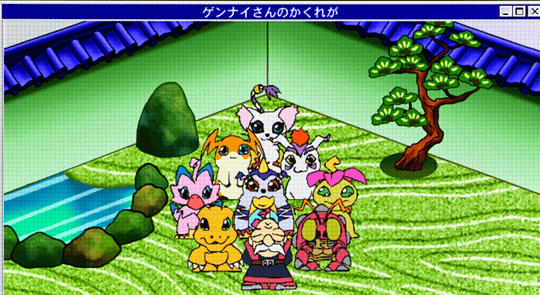 DIGIMON
DIGIMON

You have found this little earth I have been digging in this corner of the Forest, dedicated to my special interest in early Digimon media! Welcome! If you would like to read the enraptured stridulated-yip noises made by a bugfox about their love of media involving digital monster companions, you've arrived at the right place. Feel free to take one of the Tentomon plushes from over there and make yourself comfortable in that pile of leaf litter. :3
To-do list (as of 14/05/2025)
- Add introduction detailing the history of Digimon from 1997-2000. Also detail my own personal connection to the media from that era too.
- Add section intended specifically for discussing Digimon World (and the two sequels that have more or less no relevance to the first game at all, lol).
Introduction
To be specific, this page concerns the the earlier Digimon media, specifically from the period of 1997-2000 (if not potentially up to 2001), which I am extremely fond of. Generally speaking, the original Digimon Virtual Pet Toys, the 1999 Digimon World video game and the 1999 Digimon Adventure animated series.
PLACEHOLDER TEXT. THE REST OF THIS SHRINE WILL BE ADDED IN DUE COURSE.See also (mostly external links):
| Link | Description |
|---|---|
| Bogleech-Digimon monster design reviews | A section of Jonathan Wojcik's website dedicated to reviewing and rating monster designs from the various Digimon media. |
| Digi-Battle | A website containing an archive of scanned card images from Digi-Battle, one of the earlier iterations of the Digimon trading card game. It's fun to peruse; I myself am very fond of a number of the card artworks from the earlier sets! |
| Digimon World: Prima's Official Strategy Guide (via Internet Archive) | The official English language strategy guide book for Digimon World, originally published in 2000. Do note that some of the information provided in the evolution section of the guide is at times incorrect or incomplete (I would therefore advise using Grindosaur linked below, which is much more reliable for information of evolution requirements in the game). The guide nonetheless does have some great images of both the in-game 3D Digimon models and some cute render art featured in the instruction manuals for the game! |
| FoxBugForest-Digimon World (1999) Iceberg | An iceberg chart-style page about Digimon World, indeed written by the bugfox custodian of this website! |
| Grindosaur-Digimon World Wiki | An excellent wiki hosted on the website Grindosaur (ran by Raextor), dedicated to Digimon World. I myself have found it especially helpful as a guide for evolving my Digimon into certain species in the game! |
| Wikimon | An expansive fan-run wiki site for all things Digimon. |